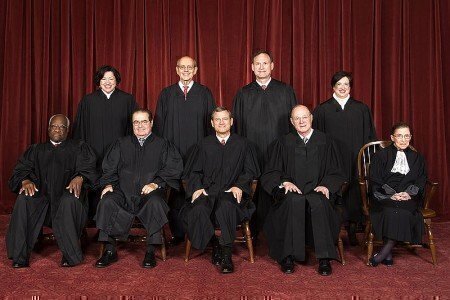Two Justices who were previously supportive of using video cameras in the Supreme Court have apparently backed off their positions.
 As the Court takes some down time in February, Elena Kagan and Sonia Sotomayor made recent public appearances where they seemed less than excited about the prospects public cameras being used to record Supreme Court arguments.
As the Court takes some down time in February, Elena Kagan and Sonia Sotomayor made recent public appearances where they seemed less than excited about the prospects public cameras being used to record Supreme Court arguments.
Justice Sotomayor told an audience in Florida that she now had concerns about how cameras would affect the justices hearing cases and the attorneys presenting them.
"I am moving more closely to saying I think it might be a bad idea," she said, saying that people may see the courtroom as more of a stage.
Justice Kagan made similar remarks in an appearance in Chicago and she compared the influence of cameras in the courtroom to that of cameras that broadcast live, and on a delayed basis, in Congress.
"If you look at different experiences, when cameras come into a place, the nature of a conversation often changes," Kagan said the University of Chicago's Institute of Politics. "Honestly, I don't think Congress is a great advertisement for this."
Both Sotomayor and Kagan supported the use of cameras in testimony given to the Senate during their confirmation hearings.
At least three other Justices are on the record as opposing cameras in the courtroom, and late last year, Chief Justice Roberts said supporters of new technology at the court shouldn’t hold their breaths.
Roberts used the example of the installation of pneumatic tubes in the current Supreme Court building to show how carefully, and slowly, the Court embraces change. The compressed air tubes were all the rage in 1893, Roberts said, as a way to send documents around buildings. The Court waited until 1935 to adopt the technology and then stopped using it in 1971.
“Courts are simply different in important respects when it comes to adopting technology, including information technology,” Roberts said. “While courts routinely consider evidence and issue decisions concerning the latest technological advances, they have proceeded cautiously when it comes to adopting new technologies in certain aspects of their own operations.”
Still, with the Court seemingly opposed to cameras documenting its proceedings, some politicians and advocacy groups are pushing for courtroom video.
Two senators quickly criticized Roberts last December for not mentioning cameras in his annual report on the courts.
“I agree with the chief justice that the judiciary must continue to do more to employ technology so that Americans have access to their courts.” said Senator Patrick Leahy (D., Vt.). “Not mentioned in his report, however, is the failure of the Supreme Court to allow even old technology, like photographs of the Supreme Court in session or live streaming of its oral arguments online.”
The Senate Judiciary Committee’s top Republican, Iowa Senator Chuck Grassley, was equally critical. “Chief Justice Roberts rightly promotes how the courts have embraced new technology,” he said. “Unfortunately, though, the courts have yet to embrace the one technology that the founders would likely have advocated for-cameras in the courtroom. The Founders intended for trials to be held in front of all people who wished to attend.”
The arguments against cameras in the court room are straightforward: the people on camera (Justices and attorneys) might “showboat” for the cameras; the media could selectively use video clips to misrepresent information; and basic fair trial rights are at risk because the presence of video would make proceedings political, as well as judicial.
Sonja R. West from the University of Georgia School of Law looked at the history of cameras and the Supreme Court in a 2012 law review article, and she came to the conclusion that the vividness and accessibility of video make it much different from the audio recording released by the Court. But she also acknowledged that allowing cameras in the courtroom would be a tough sell, with so many current, retired and former Justices on record against it, or undecided about the issue.
“The Justices often respond to arguments for video cameras in oral arguments by noting how very public the work of the Court already is-and they're right. In many ways, the judiciary is the most open branch of government,” she said.
The Supreme Court audio recordings date back to October 1955. But the recordings were only available to the Justices, clerks and researchers, with usage restrictions, until 1993. After a dispute with a political scientist who published select audio records, the Court allowed audio to be available to the general public without restrictions.
It wasn’t until 2010 that audio of Supreme Court arguments was made available during the current term, but now audio is available on a weekly delayed basis.






